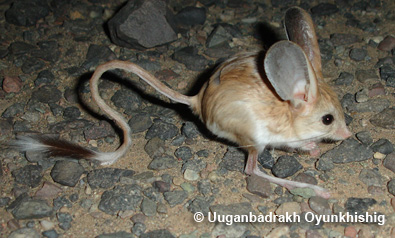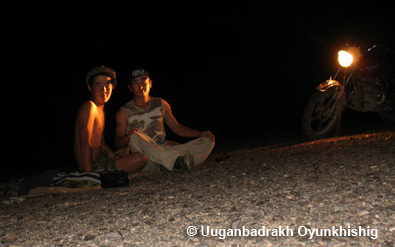Our Mongolian EDGE Fellow Uuganbadrakh has just sent us some more information and photos that he has collected while studying the Long-eared jerboa in Mongolia.
Here is what he sent us:
I thought I would tell you a bit more about my study animal- the Long-eared jerboa.
A Long-eared jerboa’s body measures around 7-10 centimeter with a tail length of up to 18 centimeter. Their hind foot is extremely long in comparison to their body length. The length of their front foot is 34 – 68% of the length of the hind foot. It is thought that a long hind foot evolved to facilitate longer and higher jumping. Jerboa’s front feet and tail help direct their body and perform important control for movement. The hairs at the end part of tail get longer and generate a “bobble” that is called bunch which aids with balance. Part of Long-eared jerboa’s back is a brown and sandy orange colour and is covered in hairs that are soft and dense. The main part of Long-eared jerboa food contains different insects and to a lesser extent vegetation. This relates mostly to the climate and season of that time, as seasons and conditions change, the diet of the Long-eared jerboa changes accordingly.
There are 5 fingers at each hind and front feet and the nails of all feet are well developed. After watching the films taken of jerboas burrowing, you could see that the Long-eared jerboa’s nails are very hard and used mainly for digging holes. Most species of the jerboa family have got big eyes. Because Long-eared jerboas have got such tiny bodies and big ears, they don’t go out during strong winds.
After setting pitfall traps to study them we had to make sure the traps were checked regularly to ensure no jerboas were hurt by other species falling into the traps. To make sure we could check the traps frequently we used to sleep near field area.
Long-eared jerboa noses are hog-like and this shape helps the jerboa forage and dig to find food and shelter. Jerboas are very good at digging and create their own burrows that they then seal once they are inside. This helps protect them against predators and the hot sun.
When long-eared jerboas run, they stick their big ears flat on their back to reduce air resistance. Long-eared jerboa are much faster than other jerboas.
To help support Uuganbadrakh collect important data that will contribute to a conservation action plan for the Long-eared jerboa click HERE




